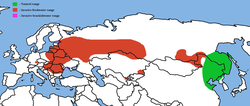| Chinese sleeper | |
|---|---|
 | |
| Chinese sleeper in an aquarium | |
| Scientific classification | |
| Kingdom: | Animalia |
| Phylum: | Chordata |
| Class: | Actinopterygii |
| Order: | Gobiiformes |
| Family: | Odontobutidae |
| Genus: | Perccottus Dybowski, 1877 |
| Species: | P. glenii |
| Binomial name | |
| Perccottus glenii Dybowski, 1877 | |
 | |
| The range of the Chinese sleeper (native in green; introduced in red) | |
| Synonyms | |
| |
The Chinese sleeper (Perccottus glenii), also known as the Amur sleeper, is a species of freshwater sleeper native to the Amur River basin in eastern Asia with introduced populations in other regions of Eurasia. It is currently the only known member of its genus. [2]


